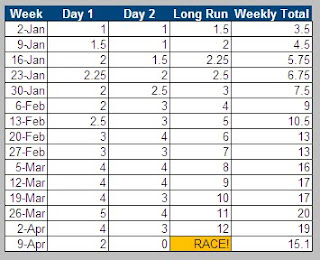While last week was the official kickoff of the Athleta half marathon training program that I’m leading, it was a bit quiet last week due to it being New Year’s Day – we had a small group of four. This week, however, about a dozen women showed up for the seminar and run, and I started to realize just how popular it was going to become! I also got some requests from people who don’t live in NYC to share the training plan, and that gave me an idea – why not post the plan as well as some highlights from the seminar here on the blog, so people near and far can participate? Whether you’re planning to run the More Half Marathon with us in April (note: registration opens tomorrow!) or a different race entirely, I’d love for you to follow along and share your own training stories.
Today’s seminar was really more of an intro to the training plan, and focused on the benefits of running. I introduced myself and told my story, most notably emphasizing that my mantra is to run relaxed and not stress over training plans. I believe that the surest way to avoid injury is to be flexible in your training plan – if you listen to your body, it usually tells you what it needs. So before I even post the distances for this training plan, I want to emphasize that the first rule is to ignore the training plan when you need to. In particular, if you miss a run, don’t double up to try to make up for it – just go with the flow and stay on schedule for your next run.
This beginner training plan is designed so that there are three runs every week – two shorter runs during the week (almost always 4 miles or less, so you don’t have to stress about making a lot of time on a weekday), and one long run on weekends. I’ll be leading a long run of the appropriate from the Athleta Upper West Side store on Sunday mornings (and will be organizing brunches and other fun post-run gatherings once we start increasing the distance a bit), but feel free to do your long run anytime during the weekend that makes sense for your schedule. The long run is really the most important on the schedule (which is why it’s scheduled for a weekend, when you hopefully have a bit more time) – if there’s one thing to prioritize, it’s that. The weekday runs are a bit more relaxed – if you miss it, it’s really not the end of the world at all.
The training plan was also designed so that total mileage doesn’t ever go up drastically (the biggest jump in total weekly mileage is week 13, when it goes from 17 miles to 20 miles – or one extra mile for each run). Meanwhile, the long run increases steadily by 1/4 mile in weeks 3-4, 1/2 mile in week 5, and then by 1 mile for all subsequent weeks. The idea is that you’ll never have to do more than about an extra 10 minutes from what you did the last week – totally doable, right? Everyone who showed up today thought so, and I hope you agree 🙂 So here is your mission, should you choose to accept it:

Today was the end of week 1 (with the week starting on Monday January 2nd), and we did a “long” run of 1.5 miles. That means sometime between now and Friday, you should aim for another 1.5 mile run and then a 1 mile run. If you don’t have a GPS/Garmin/etc, you can measure distance using the handy and free Gmap Pedometer – or just play it super casual and run for about 11 minutes per mile (so this week, doing runs of 17 minutes and 11 minutes, respectively). However, I would note that for an absolute beginner, this plan is distance-based, meaning that the time it takes you to do a run is much less relevant than the actual distance covered. This plan is designed to help a beginner finish a marathon (rather than achieve a specific time goal), and so walk, jog, or sprint, the distance that you cover in each workout is really the most important thing. Take any walk breaks you need along the way to pace yourself and finish the prescribed distance for each workout!
While on our run today, our group discussed whether to run with music (I adore it, but make sure your headphones are a style that lets you hear everything around you – I like AirDrives, though they can be a bit pricey; for a cheaper though not quite as great model, check out the 2XL Groove Hangers by Skullcandy), and how to stretch after a workout to prevent injuries (ladies, our hip flexors and IT bands are especially prone to injury – I really like this hip flexor stretch and its variants as well as a foam roller/rolling pin/wine bottle to knead your thighs post-workout).
I also shared with the group my secret weapon – whenever I’m on a training run and am within about 100 yards from my front door/other end point, I always sprint that last little bit. It helps you to gauge how much you really had left in the tank (and perhaps adjust your next run accordingly), and also prepares you for that last minute push to the finish line you’ll want to do in a race. (Bonus: it makes you look awesome and super strong in front of the spectators at the finish line, and often helps you “chick” some unsuspecting guy).
Next week, I’ll be off running the Bermuda Marathon, but a long run will still go on from the Upper West Side store – and the week’s seminar will be on “what to wear” while running. I’ll do a post later in the week with my thoughts, but let me just say that running technology has come a long way, and there is a lot of fantastic stuff out there. More to come!
I’d love to hear any of your thoughts/questions on the training plan, the benefits of running, or topics you’d like to have us cover in the future. Comments welcome!

I think it’s awsome that you’re leading a training group. I’ve been following your blog for awhile and I still don’t know how you manage to fit everything into your schedule.
I’m curious about why you included a 12 mile long run the week before the race. Obviously there are different philosphies behind every training plan, but I feel as though most plans I’ve seen have the longest run two weeks out. Since this is a beginner plan, is one week enough time for the legs to rest and recover before the race?
Hi Lisa – great question! My main objective in building this plan was consistency. Because the long run and total weekly mileage scales up at a slower pace than most, the idea is that the body will get a chance to adjust to the new long run distance while minimizing soreness/injury. The long run is intended to be run at about the same pace every week, so as long as people aren’t taking it easy each week and pushing it for speed in the final week, soreness/fatigue should be minimized. My philosophy is really around making the long run natural to your body – the way 26.2 miles became natural to me after multiple marathons.
That was sounds great, thanks for sharing this to us. An inspiration to all the runner, Congratulations for a great job well done. Looking forward always for more updates.